Ever find yourself in a jam—literally—while using your hand plane? Discover how tiny gaps and overlooked details could be sabotaging your woodworking! Ready to fix it?

The hand planer is a popular woodworking hand tool used for shaping wood, fine-scale planning, and many other woodworking tasks.
When I was a beginner, I felt frustrated because my hand plane kept jamming and skipping.
Then, I did some research and found out how to fix the jamming issue thanks to the experts.
So, here’s, how to fix the hand plane keeps jamming,
To fix a hand plane that keeps jamming, ensure a snug fit between the chip breaker and the iron blade. Use a flashlight to check for gaps. If gaps are found, dress and polish the chip breaker edge with a file or diamond stone and sandpaper for a seamless fit.
But there’s more to know about the hand plane keeps jamming.

In this article, I’ll explore why the hand plane keeps jamming and how to fix that with simple methods.
Plus, I’ll discuss hand plane troubleshooting tips and tricks based on my own experience.
Furthermore, I’ll answer some frequently asked questions as well.
Let’s jump in!

Why Does Hand Plane Keep Jamming?
Most of the time hand plane keeps jamming because the chip breaker not fit well to the iron blade. When there’s a gap between the chip breaker and the iron the plane suddenly stops cutting.
The chip breaker should match up with the iron perfectly to get nice clean cuts without jamming the hand plane.
If the chip breaker and the iron fit well, you won’t see light in between them. But if you see even a tiny bit of light through them that’s the reason why your hand plane keeps jamming.
When you’re using the hand plane, shavings can get through the space between the chip breaker and the blade.
When the shavings get caught between the chip breaker and blade, they’ll jam up behind it and clog the mouth solid.
When you don’t have a nice tight fit between the chip breaker and the iron, the chip will be coming up and the iron will cut into the wood and create a curl.
That curl will then slide up the iron and if the curl is thin enough, it will go in between the chip breaker and the iron. Then it will start jamming up in there.
It’s not a problem for the first pass or two because the curl will still pass. But then eventually the space in the plane up front will be so tight in the mouth.
Eventually one chip will catch the next one and suddenly it will jam up the entire mouth. Nothing can get through the slot.
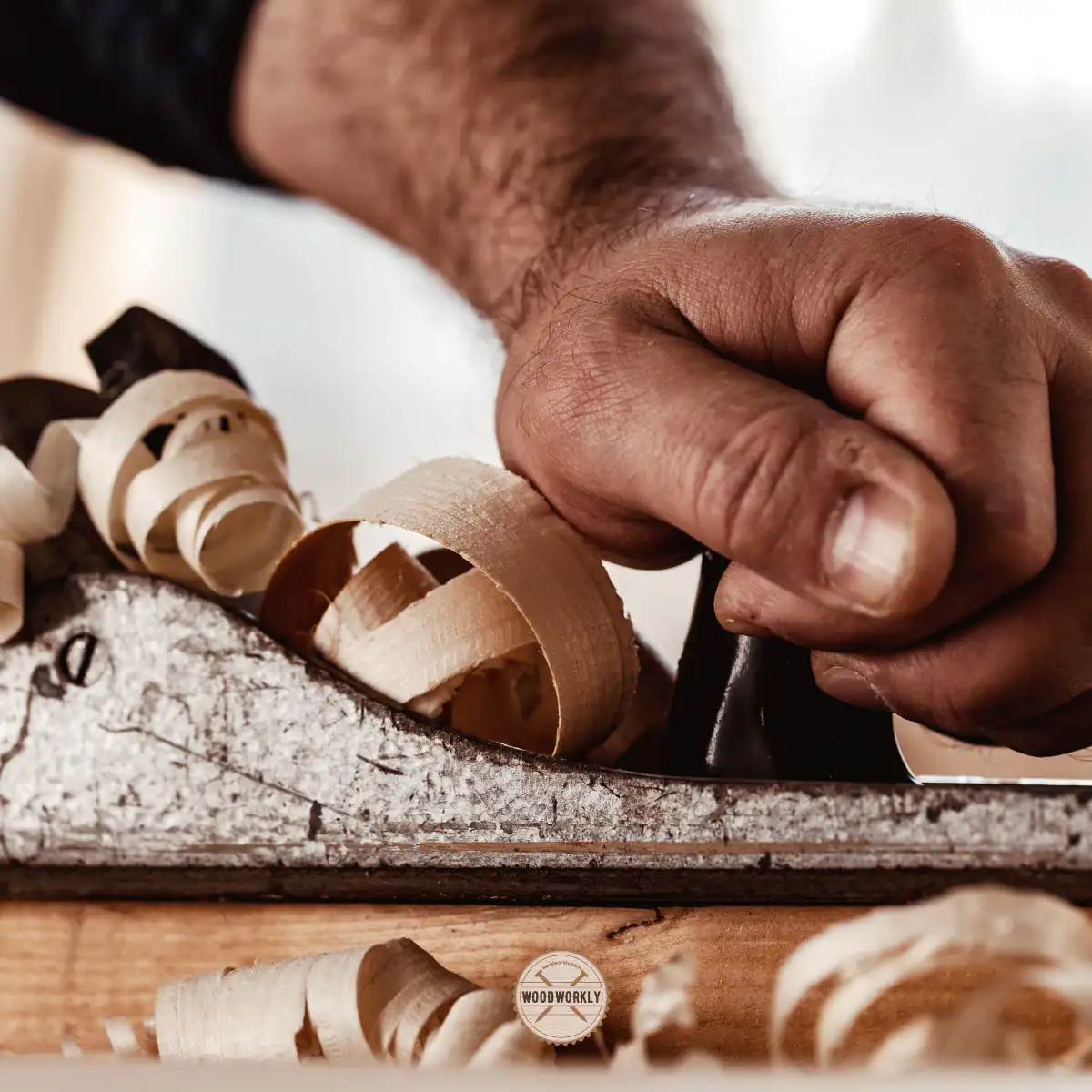
Another reason why for hand plane keeps jamming is when the wedge tips are too far beyond the chip iron curves and when the wedge tips are shrunk narrower than the plane mortise.
You can identify this by seeing through the plane mouth for the wedge tips. Use a flashlight and see if there’s a gap between the tips of the wedge and the mortise.
Shavings may get trapped between the wedge and mortise since skewing points the shavings directly. This will cause the hand plane keeps jamming.
As a summary, here are the possible reasons that cause the hand plane keeps jamming,
- Having a space between the chip breaker and the iron
- Wedge tips are too far beyond the chip iron curves
- Wedge tips are shrunk narrower than the mortise
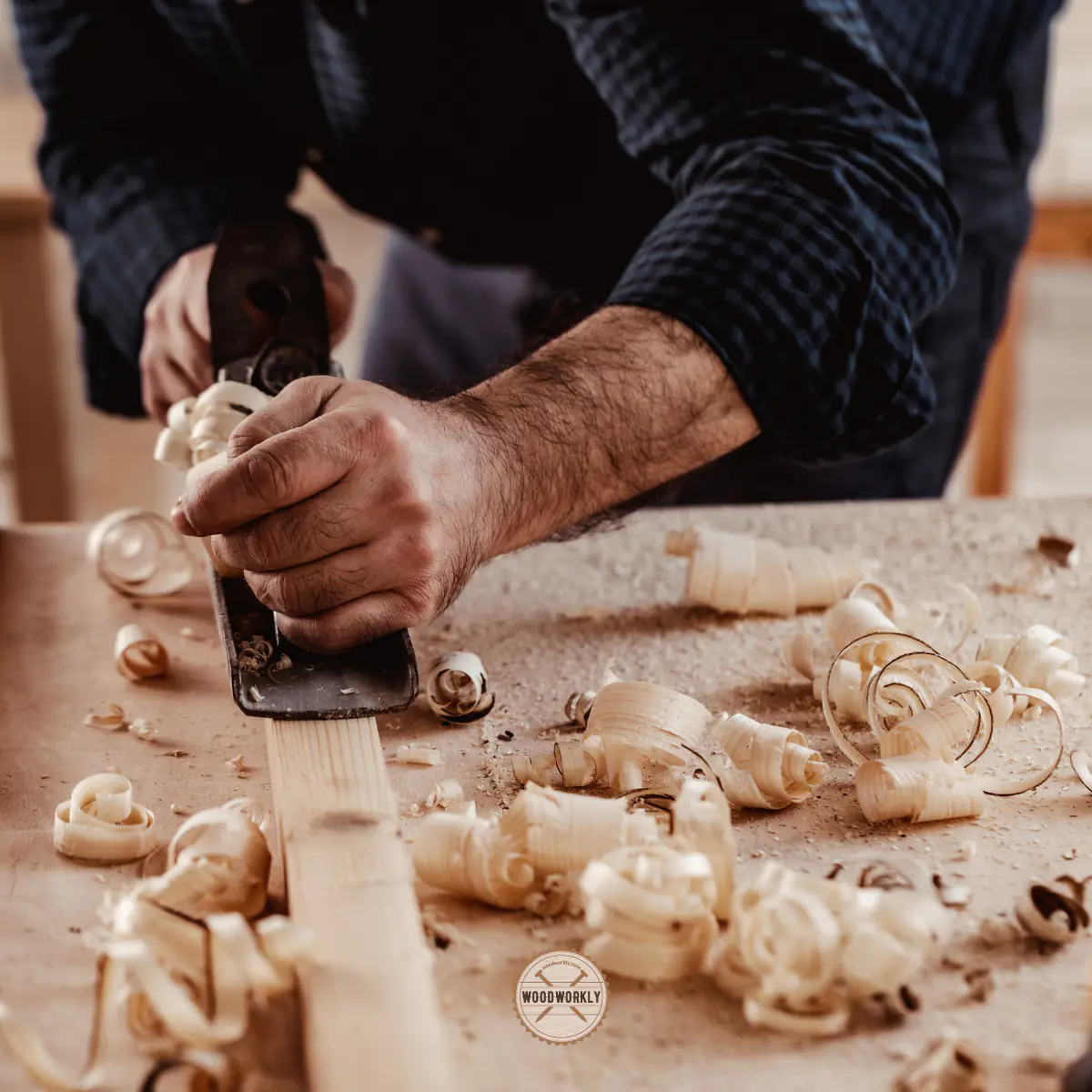
So, let’s find out how to fix the hand plane keeps jamming effectively.
Supplies You Will Need to Fix the Hand Plane that Keeps Jamming
- Flashlight
- Hand plane chip breaker and iron blade
- File or diamond stone
- Sandpaper
How To Fix Hand Plane Keeps Jamming?
You can fix the hand plane keeps jamming by matching the edges of the chip breaker and iron with no gaps. When they are perfectly fitted, hand plane won’t jam anymore.
Let’s see how to fit them with ease.
Here are the simple steps you need to follow to fix the hand plane keeps jamming,
- Clean the mouth and remove shavings
- Use a flashlight between the chip breaker and the iron
- Check for gaps
- Dress the chip breaker edge
- Polish the chip breaker edge
- Match and contact the chip breaker and iron
So, let’s discuss each of the above steps in detail to get a clear idea of fixing the issue.
1. Clean The Mouth and Remove Shavings
First, you need to clean the hand plane mouth to remove wax, shavings all other residues that clog the mouth.
When the hand plane is jamming, that’s probably because of the clogged mouth.
So, before fixing the jamming you need to remove anything in between the chip breaker and iron before going into the next step.
Plus, make sure to take your hand plane to a desk with good lighting since that’s how you can identify the issue correctly.
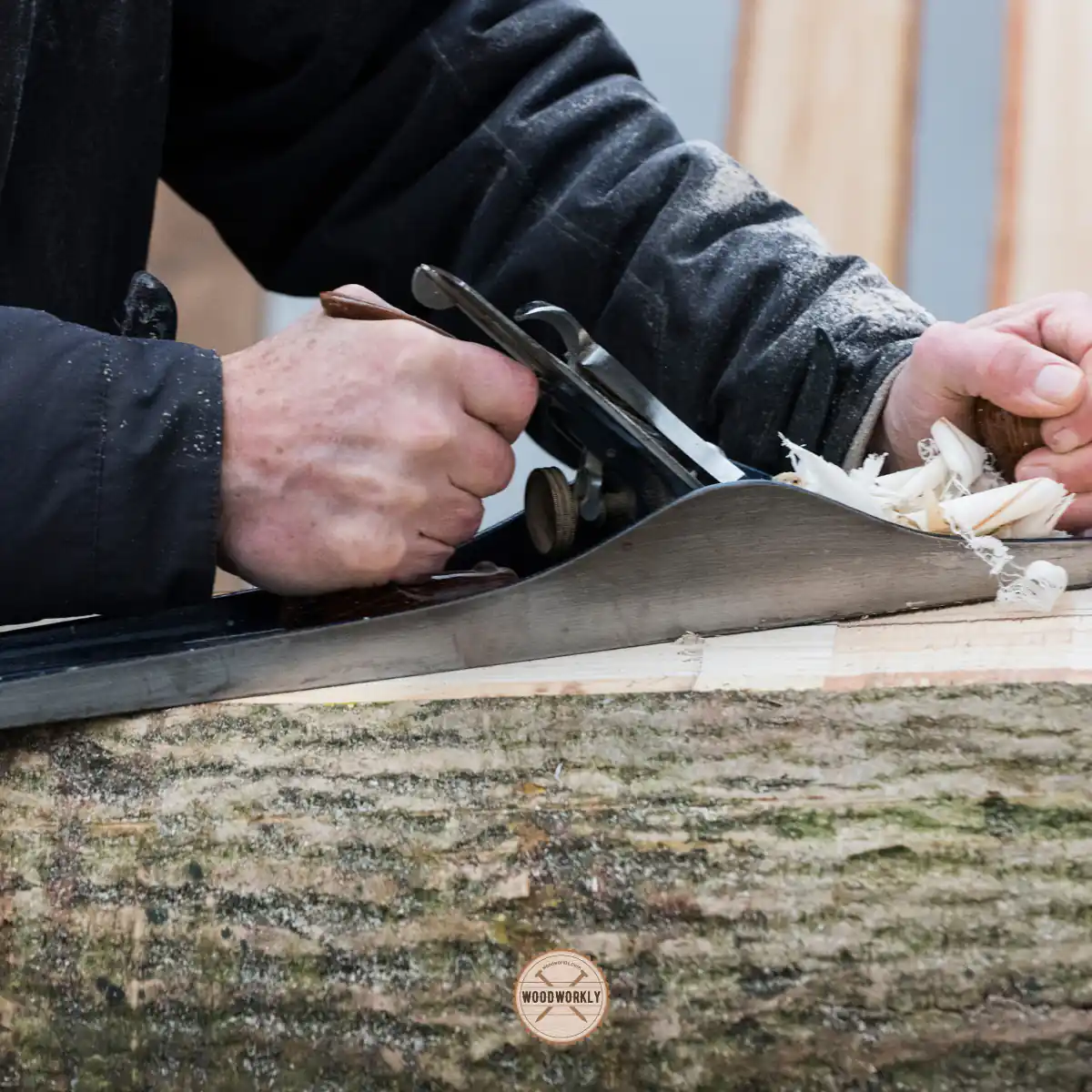
2. Use Flashlight Between Chip Breaker and Iron
First, you need to take the chip breaker and the iron to the same position and head the flashlight directly through the eye of the chip breaker.
To know that the chip breaker is well fitted with the iron, look through the eye of the chip breaker and hold it up to the light.
Then look through the eye and look up at the tip inside the hole and see if you notice any light coming through in between the chip breaker and the iron.
3. Check For Gaps
While the flashlight is on, turn your head and monitor the chip break eye carefully to identify if there’s any light comes out in between the chip breaker and the iron.
If there’s any gap between the chip breaker and the iron, you’ll see a light leakage with the help of a flashlight.
If you see any light coming out between the two surfaces, that’s what you need to work on in the next step.
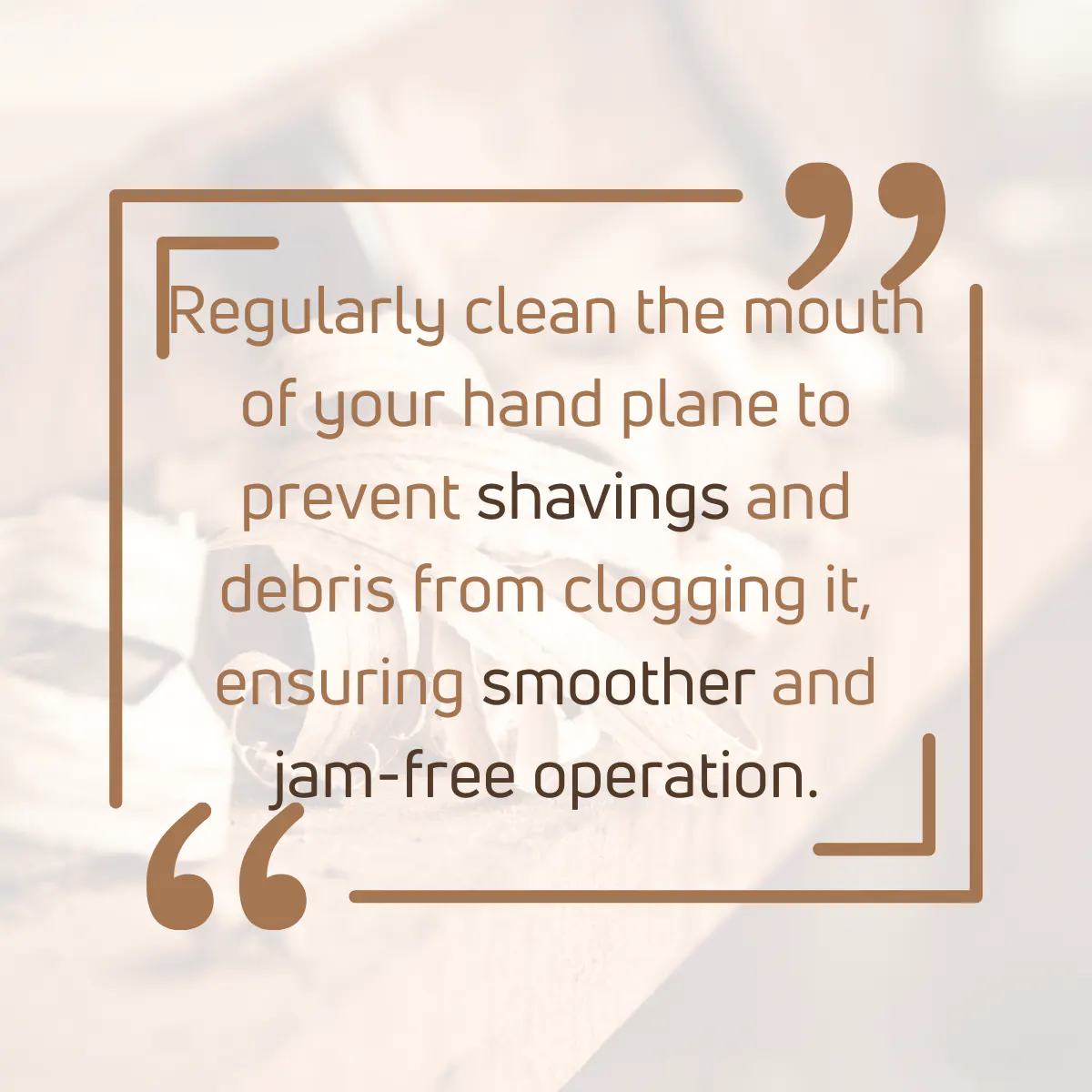
4. Dress The Chip Breaker Edge
To make a nice matching surface between the chip breaker and the iron, you need to dress the chip breaker edge to flatten and smoothen the surface.
Place just the tip of the chip breaker onto the iron itself and dress with the help of a file or diamond stone.
After placing the tip of the chip breaker onto the iron, lower it down below the edge and dress using a side-to-side motion.
Clean and smoothen the chip breaker edge. Hook your fingers over the edge of the bench.
Then round the top of the chip breaker and dress.
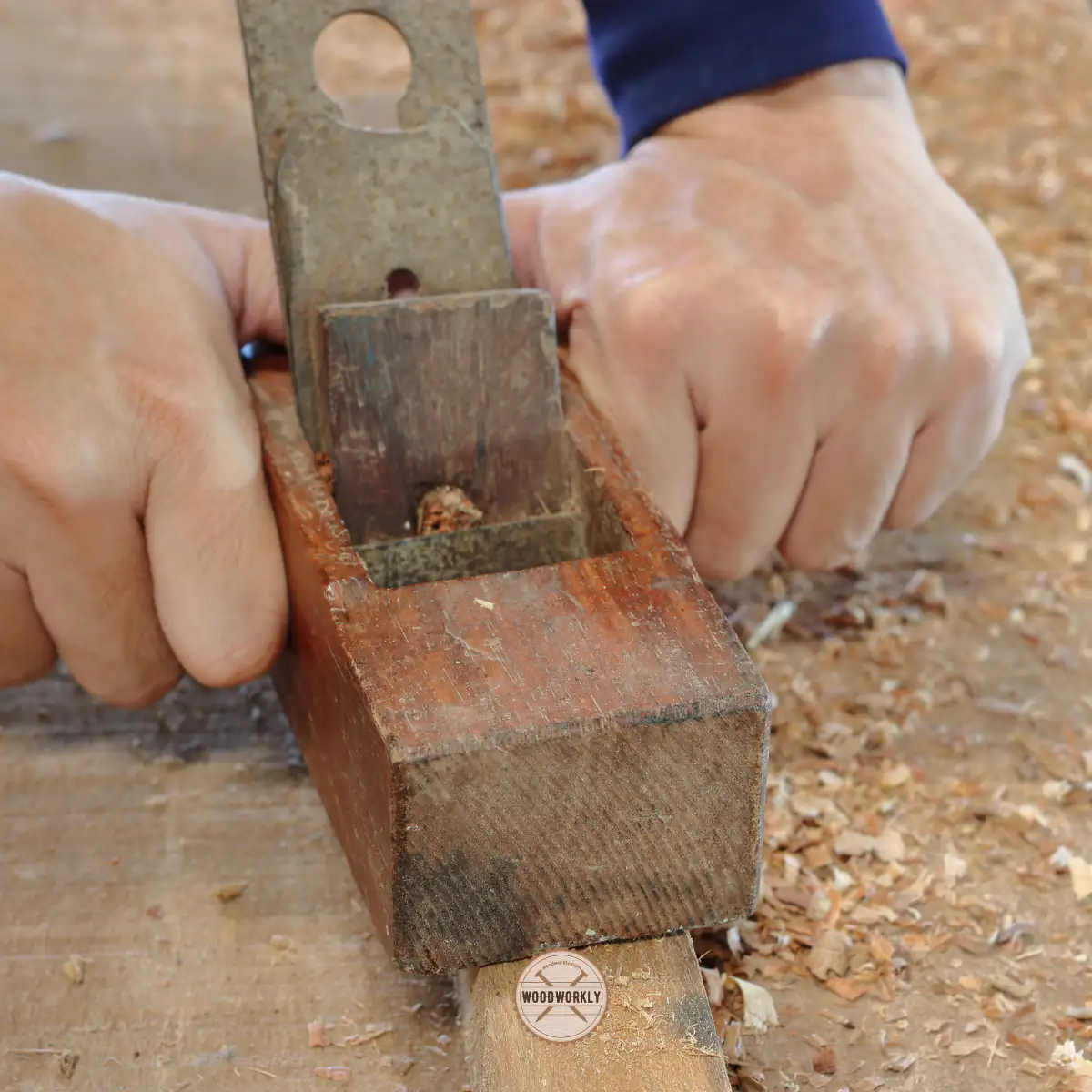
5. Polish The Chip Breaker Edge
Once you’re done with dressing, sharpen, flatten and smoothen the chip breaker edge with sandpaper to remove bumps and randomness.
Finally, you can use a buffing wheel to polish the chip breaker edge even more.
6. Match And Contact Chip breaker and Iron
Now place the chip breaker and iron blade together and assemble them with a screw.
Then check the chip breaker edge and iron blade edge and see if there’s any gap between them.
If you have followed the procedure correctly, there should be no gap between the chip breaker and the iron blade.
Now your hand plane is ready to work on shaping wood without jamming.
Now you have a good understanding of fixing a jammed hand plane with ease.
Let’s see some troubleshooting tips regarding common issues of a hand plane.
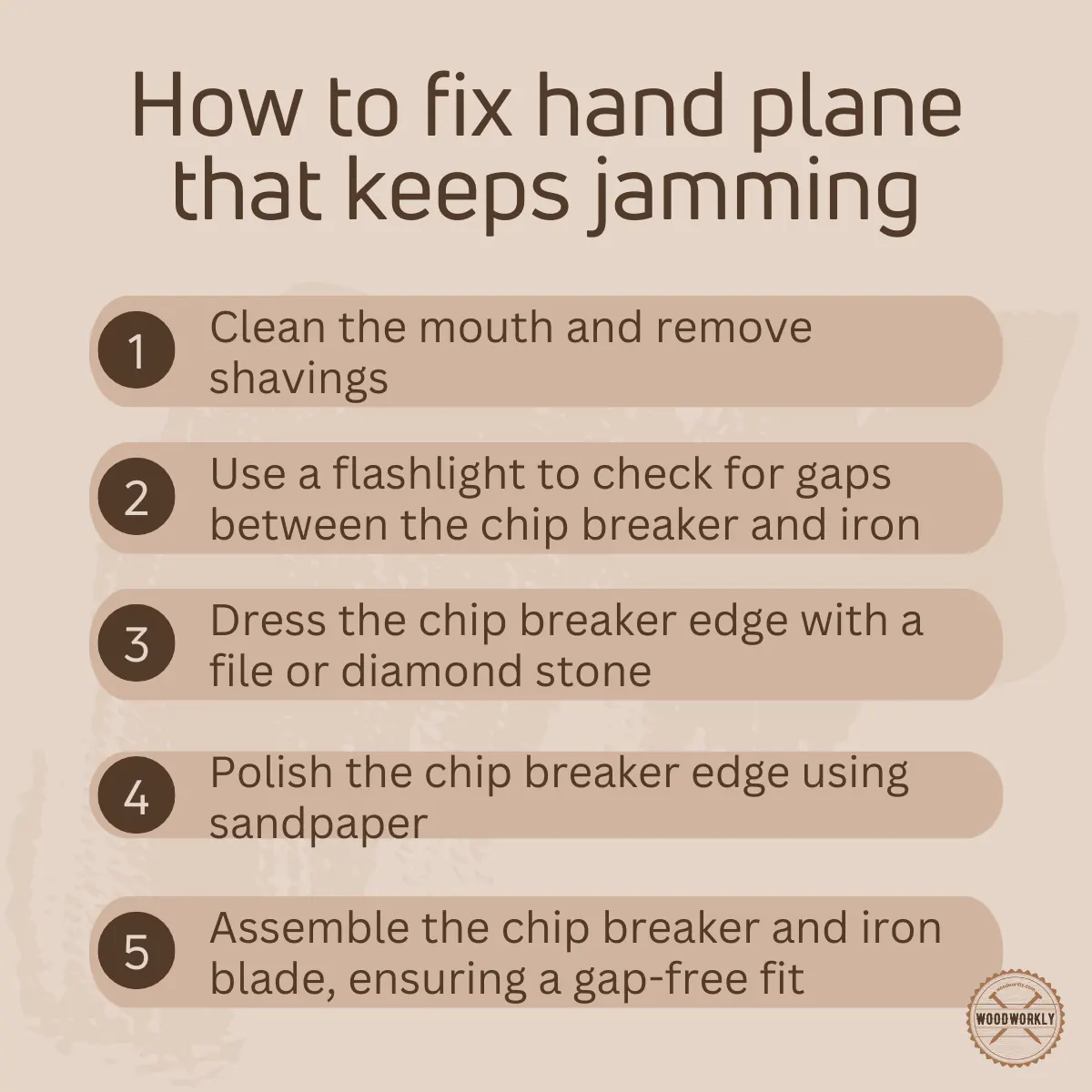
Hand Plane Troubleshooting Tips
Follow the below chart to fix some common issues of a hand plane to get good knowledge about what actions you should take to fix them easily.
| Symptom | Reason | Solution |
|---|---|---|
| Jamming | Gaps between the chip breaker and iron blade | Dress the chip breaker edge |
| Cuts the beginning and end of the board, not the middle | The plane sole is not well flattened | Flatten the sole using sandpaper |
| Blade stops cutting | Backlash in the adjustment technique | Set the final depth of the blade by adjusting it downward |
| Chatter | The blade is not well clamped | Clamp the blade well by increasing the clamping pressure |
| Plane leave marks on the surface | The blade is not leveled or corners are shrunk | Level the blade by dressing it up |
| Tear-outs | The chip breaker is placed too far back or when the mouth is too large | Adjust the chip breaker position |
Now you have a clear idea of fixing some common issues of a hand plane.
That’s it, folks! Hope you gathered a good understanding of why the hand plane keeps jamming and how to stop it.
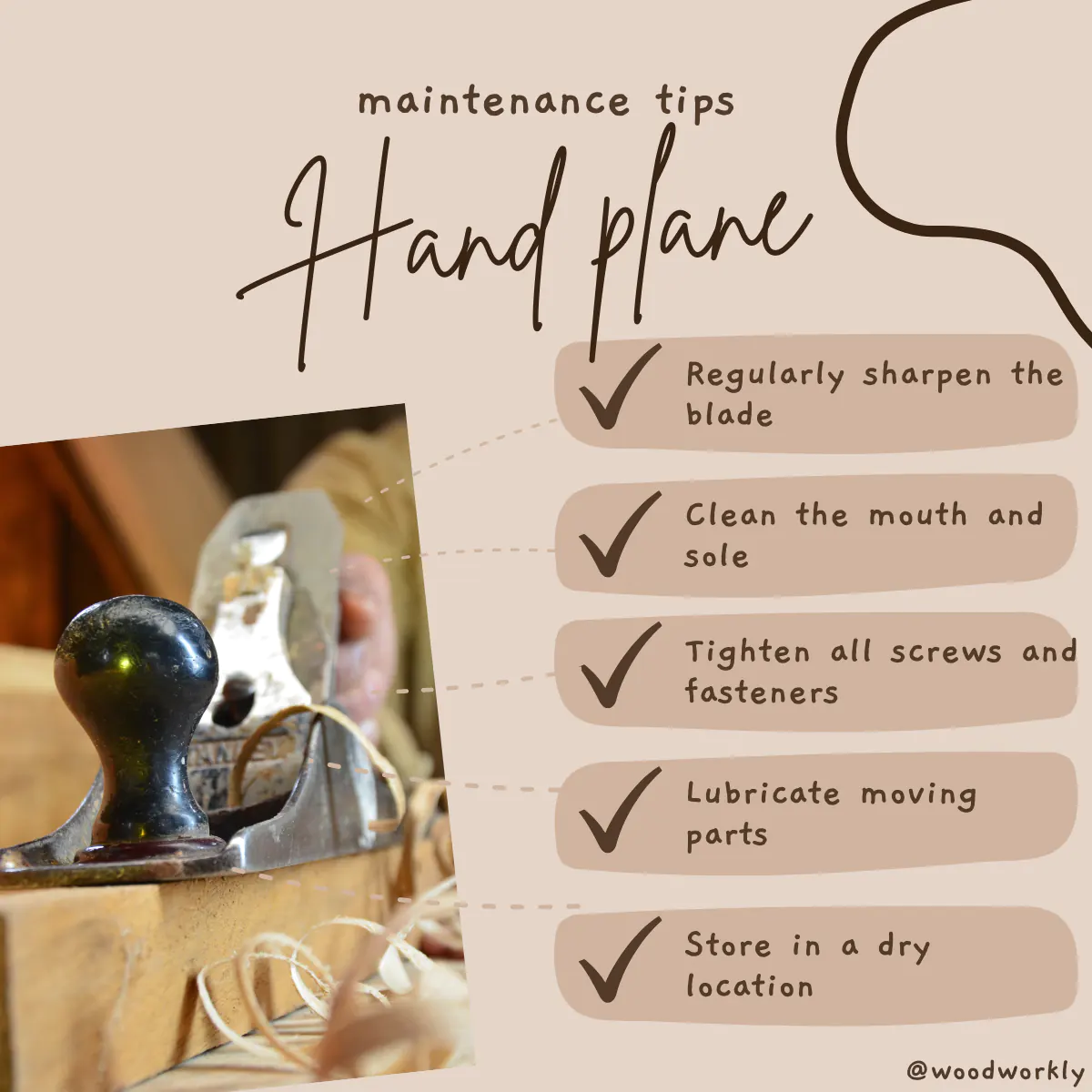
Why Does My Hand Plane Keep Skipping?
The hand plane keeps skipping when the iron blade is too dull, the stroke is not in a steady position, or when the shavings are too thick.
You can fix the hand plan that keeps skipping by dressing the iron blade by sharpening, fixing the stroke, and fixing the iron blade by retracting.
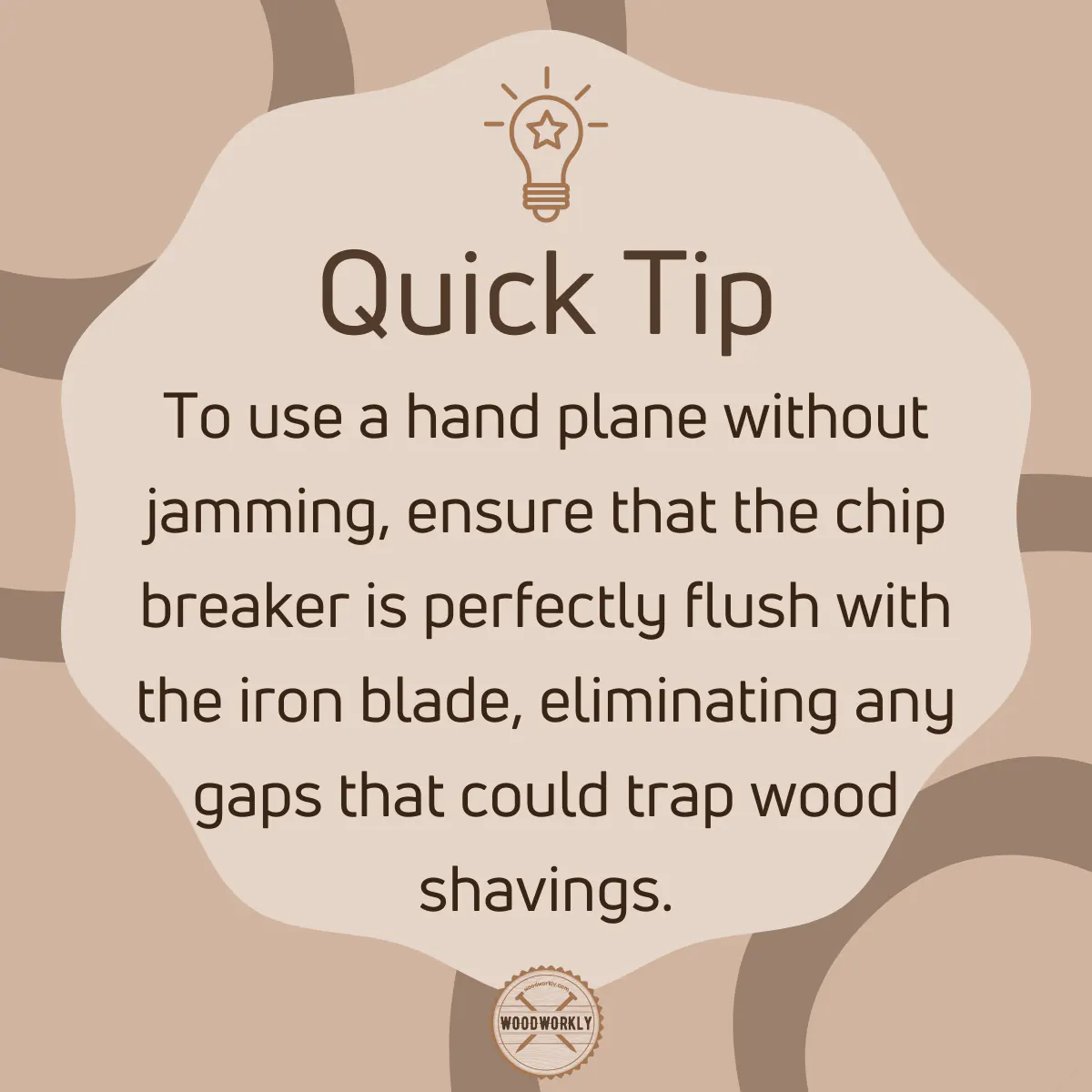
Why Does My Hand Plane Dig In?
Hand plane dig in when you planning in the wrong direction to the wood grain or when your iron blade is flexing.
The blade and the frog can be uneven, and shavings may trap inside the blade. Backlashes are one of the main reasons for the hand plane digging in.
In order to fix the hand plane digging in, make adjustments by positioning the blade down, not up. Positioning the screw downward will take up the backlash.
How Do I Stop My Hand Plane From Chattering?
You can stop the hand plane from chattering by taking a lighter cut by retracting the iron, sharpening the iron blade, fixing the gap between the chip breaker and iron, and removing the dust and debris on the bed.
Chattering is similar to skipping which means leaving a rippled surface in the wood while working on it.
Chattering happens when the pressure between the lever cap and clamp is insufficient to tighten the frog. By adjusting the lever cap, you can fix hand plane chattering.
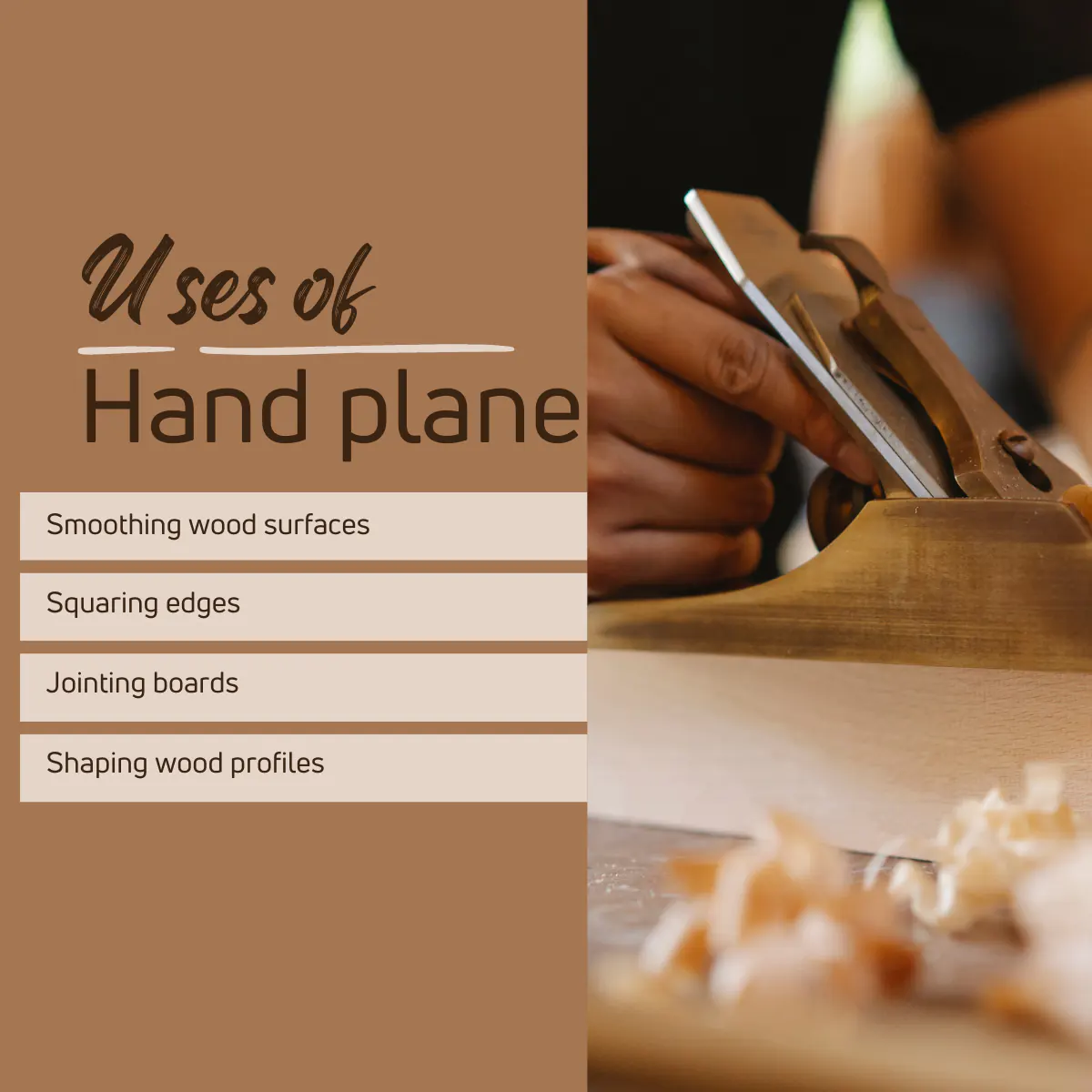
So, let’s answer some frequently asked questions.
FAQs
Why does my hand plane keep jamming?
Your hand plane may be jamming due to gaps between the chip breaker and the iron blade or misaligned wedge tips. Address these issues by ensuring a snug fit between the chip breaker and iron, and properly aligning the wedge tips to the plane mortise.
How do I identify the reason for the jam?
To pinpoint the cause, shine a flashlight between the chip breaker and iron and look for light leakage. If you see any gaps, it’s a sign that these parts need to be dressed and polished for a better fit.
How do I dress the chip breaker edge?
Use a file or diamond stone to dress the chip breaker edge, smoothing it until it perfectly aligns with the iron blade. This step is crucial for preventing future jamming issues.
Is sandpaper necessary in the fixing process?
Yes, sandpaper is used to polish the chip breaker edge, ensuring a flawless and snug fit with the iron blade. A well-polished chip breaker facilitates smooth planing.
How can I prevent my hand plane from skipping?
Hand plane skipping is generally caused by a dull iron blade or inconsistent stroke. Sharpening the blade and maintaining a steady stroke can alleviate this issue.
How can I stop my hand plane from chattering?
Chattering usually occurs when the clamp pressure is insufficient. Tightening the lever cap or taking lighter cuts can often resolve this issue.
Is it necessary to clean the hand plane mouth before fixing?
Yes, cleaning the mouth of the hand plane is essential to remove wax, shavings, and other residues that may be contributing to the jamming problem.
Did I cover all you wanted to know about How To Fix Hand Plane that Keeps Jamming
In this article, we have deeply looked into why the hand plane keeps jamming and how to fix the hand plane keeps jamming issue easily using simple steps. Plus, we’ve discussed some hand plane troubleshooting tips as well.
Hand plane keeps jamming when there is a gap between the chip breaker and the iron blade. Or when the wedge tips extend too far beyond the chip iron curves. To fix the hand plane keeps jamming, dress the bottom edge of the chip breaker with a file or diamond stone until it contacts the blade.
Furthermore, I’ve answered some frequently asked questions as well.
Hope you have gained good knowledge about fixing the hand plane keeps jamming with ease.
Try to fix hand plane issues by yourself and always make sure to match the chip breaker edge with the iron blade before working with any hand plane to not let things get messed up.